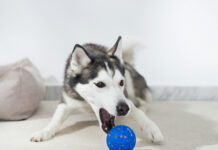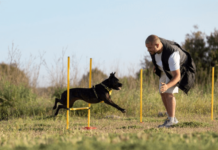Last Updated on April 1, 2024 by Dogs Vets
Dog Training 101: Repetitions for Commands
When it comes to training your furry friend, repetition is key. Dogs, like humans, learn best through consistent practice and reinforcement.
At the heart of any effective dog training regimen lies a fundamental principle: repetition. Much like their human counterparts, dogs thrive on consistency and repeated practice, making repetition an indispensable tool in the arsenal of any successful dog trainer.
In this article, we will explore the importance of repetitions for commands and how you can effectively use this technique to train your dog.
Understanding the Role of Repetition in Dog Training
The significance of repetition in dog training cannot be overstated.
When you consistently reinforce commands, you’re not just teaching your dog what actions to perform; you’re also building a language of cues and responses that form the foundation of your communication with your pet.
This consistency is crucial because dogs, much like people, learn through the reinforcement and repetition of actions and behaviors.
The Power of Repetition
Repetition is a fundamental aspect of dog training. By repeating commands and actions, you are reinforcing the desired behavior and helping your dog understand what is expected of them. Just like learning any new skill, dogs need practice to master commands.
Repetitions create a strong association between a command and the desired action. It helps your dog develop muscle memory and understand the cues you provide. Through consistent repetition, you can build a solid foundation for obedience and ensure that your dog responds reliably to your commands.
The Science Behind Repetition and Learning
Scientific studies have shown that repetition is key to learning for both humans and animals. This learning process is rooted in the concept of operant conditioning, where behaviors are learned through the consequences of actions.
By repeating a command and following it with a positive reinforcement (such as treats, praise, or play), dogs begin to associate the command with the positive outcome, making them more likely to repeat the behavior in the future.
Implementing Repetition in Your Training Routine
To effectively use repetition in your dog training efforts, consider the following tips:
- Start Simple: Begin with basic commands like ‘sit’, ‘stay’, ‘come’, and ‘heel’. These foundational commands are not only easier for your dog to grasp but also establish a baseline for more complex commands later on.
- Consistency is Key: Use the same words and gestures for each command every time. Consistency in your commands and your rewards helps your dog understand what is expected.
- Short, Frequent Training Sessions: Dogs have short attention spans. Training sessions should be short (5-10 minutes) but frequent (several times a day). This ensures that your dog remains engaged and doesn’t become overwhelmed.
- Positive Reinforcement: Always use positive reinforcement to reward your dog for following a command correctly. Whether it’s verbal praise, a favorite treat, or a quick play session, positive reinforcement makes learning a rewarding experience for your dog.
- Patience and Persistence: Some commands may take longer to master than others, and that’s perfectly normal. The key is to be patient and persistent. With enough repetition, your dog will eventually understand and follow your commands.
Creating a Training Routine
Establishing a training routine is essential for successful repetitions.
Dogs thrive on structure and consistency, so it’s important to set aside dedicated training sessions. Make sure to choose a quiet and distraction-free environment where you can focus on the training without interruptions.
Start each session with a warm-up exercise to engage your dog’s attention and prepare them for learning. This could be a simple command they already know or a fun activity that gets them excited. Once your dog is warmed up, you can move on to the specific command you want to work on.
During the training session, repeat the command clearly and consistently.
Use positive reinforcement, such as treats or praise, to reward your dog when they respond correctly. Be patient and give your dog time to process the command and perform the desired action. Remember, practice makes perfect!
Progressive Difficulty
As your dog becomes more proficient with a particular command, it’s important to gradually increase the difficulty level. This helps prevent boredom and ensures that your dog continues to learn and improve.
One way to introduce progressive difficulty is by adding distractions.
Start by practicing the command in a quiet environment and then gradually introduce mild distractions, such as toys or low-level noises. Over time, you can increase the level of distractions to simulate real-life situations.
Another way to add difficulty is by varying the context. Dogs are great at generalizing, so practicing the command in different locations and situations will help them understand that the command applies in various scenarios.
Common Challenges and Solutions
During the training process, you may encounter some challenges. Here are a few common ones and tips on how to overcome them:
1. Lack of Focus
If your dog seems easily distracted during training, try increasing the value of the rewards you offer. Use high-value treats or favorite toys to capture their attention and keep them motivated.
2. Inconsistent Response
If your dog sometimes responds correctly and other times doesn’t, it’s important to evaluate your own consistency. Make sure you are using the same command word and hand signals each time. Additionally, check if you are providing clear cues and rewarding the desired behavior consistently.
3. Plateau in Progress
If your dog reaches a plateau and doesn’t seem to be making progress, take a step back and reassess your training approach. It might be helpful to seek guidance from a professional dog trainer who can provide personalized advice and techniques.
Conclusion
Repetitions are the building blocks of successful dog training. By incorporating consistent practice into your routine and gradually increasing the difficulty level, you can help your dog master commands and develop good behavior.
Remember to be patient, use positive reinforcement, and most importantly, enjoy the journey of training your beloved companion.
Frequently Asked Questions
1. How many repetitions should I do during each training session?
There is no fixed number of repetitions as it depends on your dog’s individual progress and attention span. Start with a few repetitions and gradually increase them as your dog becomes more comfortable.
2. Can I use verbal praise instead of treats?
Absolutely! Verbal praise can be a powerful motivator for many dogs. Experiment with different rewards to find what works best for your furry friend.
3. Is it too late to start training my adult dog?
It’s never too late to start training! While puppies are more receptive to learning, adult dogs can still benefit from training sessions. Remember to be patient and consistent.
4. How long does it take for a dog to learn a command?
The time it takes for a dog to learn a command can vary depending on several factors, including the complexity of the command and the individual dog’s learning abilities. Some commands may be learned quickly, while others may require more time and practice.
5. Can I train my dog without professional help?
Yes, many dog owners successfully train their dogs without professional help. However, if you encounter difficulties or want personalized guidance, consulting a professional dog trainer can be beneficial.
6. Should I train my dog every day?
Consistency is key in dog training. Aim to incorporate training sessions into your daily routine, even if they are short. Regular practice will yield better results than sporadic training sessions.
7. Can I train my dog using punishment?
Positive reinforcement is generally more effective and humane than punishment-based training. Focus on rewarding desired behaviors rather than punishing unwanted ones. Consult a professional dog trainer for guidance on positive reinforcement techniques.
Fact Check
We strive to provide the latest valuable information for pet lovers with accuracy and fairness. If you would like to add to this post or advertise with us, don’t hesitate to reach us. If you see something that doesn’t look right, contact us!

















